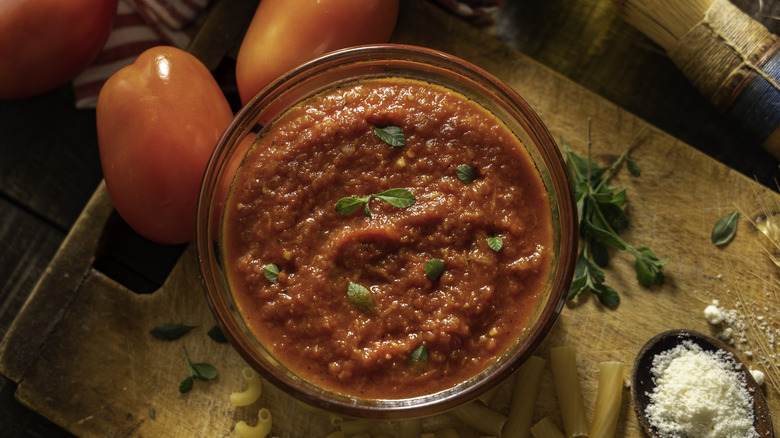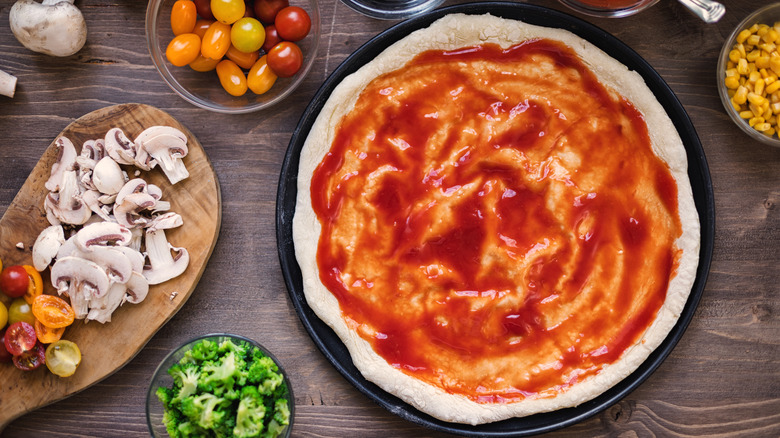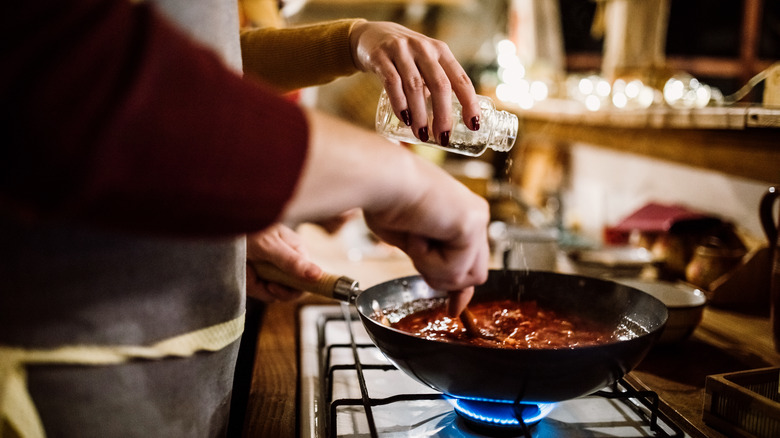Can You Use Pasta Sauce In A Pinch When Making Pizza?
Pasta sauce might just be one of the most versatile items that any home cook should regularly stock up on. From casseroles to stews and even ratatouille, this tomato-based ingredient packs a punch through its tangy, mildly sweet, and savory flavor. With so many uses for pasta sauce, people have wondered if it can also be used on pizzas — after all, the two are strikingly similar tomato-based spreads. Sadly, most pasta sauces cannot be used interchangeably for pizzas, and it has to do with how they are cooked beforehand.
Generally speaking, most pasta sauces are roasted for long periods of time before packaging. This not only gives them a richer, more concentrated flavor but allows them to be directly drizzled onto a bowl of cooked linguine without the need of cooking. Meanwhile, the majority of pizza sauces are left uncooked because they will get baked in the oven alongside the dough. If they were roasted beforehand, the pie would lose a lot of its tangy tomato flavor. Cooking pasta sauce for too long can not only burn it but cause it to dry up and caramelize.
Pomodoro sauces are the exception to this rule, as they are not simmered for long stretches of time and retain the fresh flavor of tomato. They are also relatively thin, making them easier to dollop onto pizza dough than a generic marinara or ragu.
Flavor and texture can also differentiate pasta from pizza sauce
Cooking times aren't the only thing setting apart pasta and pizza sauce. During its long roasting session, the former often becomes fortified with a wide number of seasonings. Dried herbs, bay leaves, and red pepper flakes are often found as conventional add-ons for pasta sauce, although some variants of pasta sauce can have extra secret ingredients such as sugar or even anchovies thrown in as well. Meanwhile, most pizza spreads are lightly flavored with a dash of garlic, olive oil, and oregano. This makes pasta sauces rather overwhelming for a pie, which could potentially distract from the simple, traditional taste of a Neapolitan pizza.
Texture also makes a huge difference between the two tomato-based ingredients as well. Most pizza sauces are finely pureed in order to make them easier to spread onto dough. That's not the case for their pasta counterparts, as they can oftentimes be much more irregular in feel. This usually isn't a problem for spaghetti or linguine — if anything, it adds a nice contrast to the otherwise uniform noodles — but it can be a major headache if you're trying to spread it thinly and evenly onto a dough. Most pasta sauces also have a higher water content, which can ruin the texture of pizza bread as it bakes in the oven.
On the other hand, you can use pizza sauce to dress pasta
While pasta sauce generally yields unfavorable results in pizza, the opposite may ring true for the inverse. Pizza sauce can be a great addition to freshly cooked noodles, provided that you spruce it up in a variety of ways. To get the thicker consistency of a marinara, you'll need to either simmer it on the stovetop or roast it in the oven. This will evaporate some of the water content inside the pizza sauce, reducing it to a consistency that will not be too soupy for pasta.
During this step, you can take the time to fortify this tomato-based ingredient with the seasonings of your choice. In the case of most pasta dishes, dried basil, oregano, thyme, rosemary, and garlic powder are your best bets, but feel free to add whatever spices you have lying around your pantry.
Still, you are better off purchasing pasta and pizza sauce for their respective dishes. Unless you're making them from scratch, you can store most commercial jars of pasta sauce in the fridge for approximately a year, so you'll have plenty of time to finish up both if you're implementing them into a wide array of recipes.



